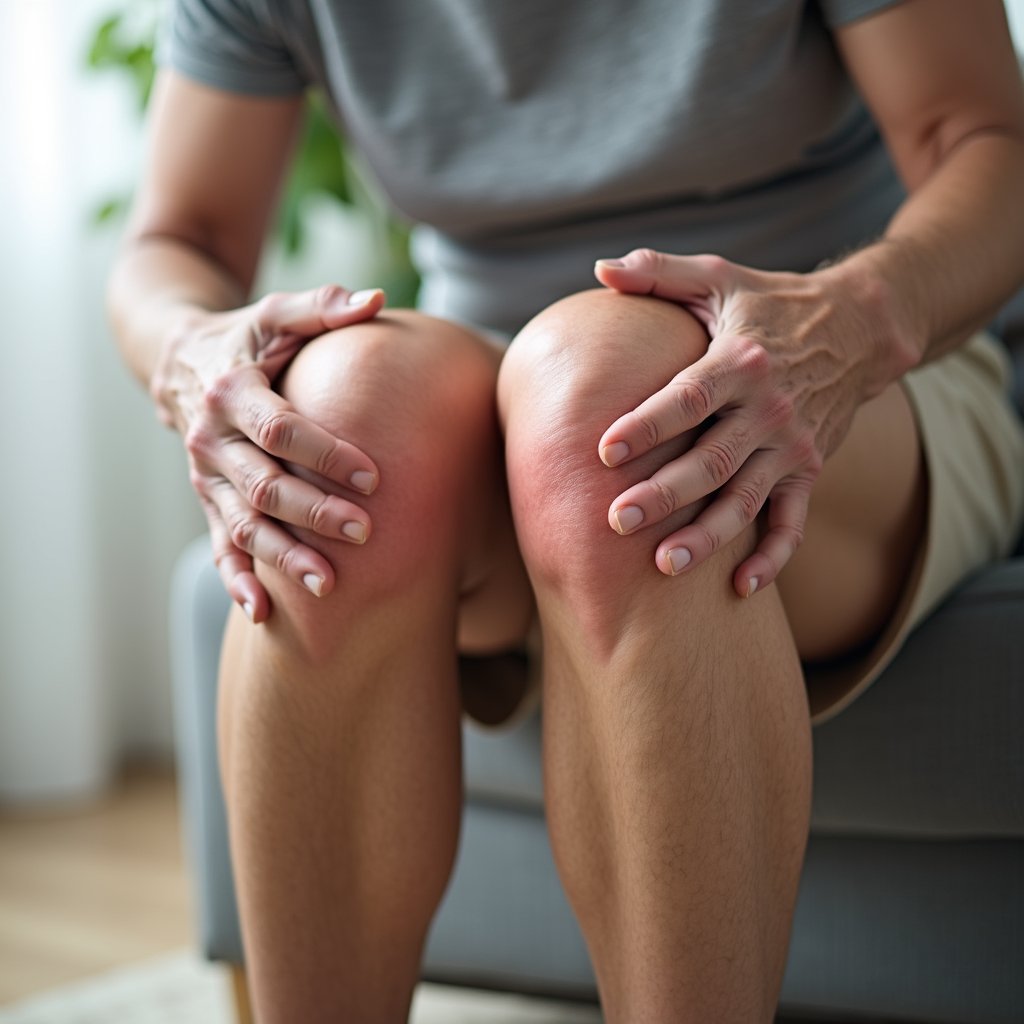Your knees bear significant weight-bearing stress during daily activities, making them highly susceptible to osteoarthritis, especially with risk factors like obesity, prior injuries, or aging. You can manage knee osteoarthritis through weight management, low-impact exercises, cold/heat therapy, and joint-supporting supplements like glucosamine. Medical interventions include corticosteroid injections, pain medications, and in severe cases, surgery. Understanding the extensive range of treatment options will help you develop an effective strategy for long-term joint health.
Understanding Why Knees Are Vulnerable to Osteoarthritis

Your knees endure extraordinary mechanical stress as the body’s primary weight-bearing joints. This constant stress makes them particularly susceptible to osteoarthritis, a degenerative condition that progressively breaks down joint cartilage. The complex structure of your knee joint, combined with its limited shock-absorption capabilities, creates vulnerability to wear and tear over time.
If you’re carrying excess weight or have experienced prior knee injury, you’ll face an increased risk of developing osteoarthritis. The condition often accelerates when you regularly engage in activities involving repetitive knee motions. As you mature, your knee joints become more prone to degenerative changes, with cartilage gradually deteriorating under continued stress. Understanding these risk factors is important, as the knee’s role in mobility makes it one of the most commonly affected joints in osteoarthritis cases.
Key Risk Factors That Impact Knee Joint Health

Your knee joint health faces multiple risk factors, with excess weight being particularly damaging as each supplementary pound magnifies the pressure on your weight-bearing joints during movement. If you’ve experienced previous knee trauma, you’re more susceptible to developing osteoarthritis due to altered joint mechanics and compromised cartilage integrity. Increased years compounds these risks by diminishing your body’s natural joint repair mechanisms, leading to progressive deterioration of knee cartilage and supporting structures.
Weight-Bearing Joint Pressure
Why do knee joints bear such a significant burden in the human body? Your knees endure substantial weight-bearing stress during daily activities, making them particularly vulnerable to osteoarthritis. When you’re carrying extra pounds, excess body weight intensifies the pressure on your knee joints, accelerating cartilage breakdown and disrupting normal joint mechanics.
- Biomechanical factors, including leg alignment and muscle weakness around the knee, can compromise joint stability
- High-impact sports and repetitive motions create cumulative stress on knee structures
- Your body weight multiplies the force exerted on knee joints during activities like walking and climbing stairs
- Anatomical variations in joint shape influence how pressure distributes across the cartilage surfaces
Understanding these mechanical stresses is pivotal because they directly influence the development and progression of knee osteoarthritis. The combination of weight-bearing demands and anatomical factors makes your knees especially susceptible to degenerative changes.
Injury History Effects
Beyond the mechanical stresses of weight-bearing, prior injuries substantially alter knee joint health and increase osteoarthritis risk. If you’ve experienced knee trauma, particularly meniscus tears or ACL injuries, you’re at higher risk for developing cartilage damage that progresses to osteoarthritis. The initial injury disrupts your knee joint structure, setting off a cascade of degenerative changes.
Your occupation and athletic activities can also impact your knee health through repetitive stress. If you’re regularly engaging in high-impact movements or maintaining awkward positions, you’re accelerating joint wear. Moreover, if you’re carrying excess weight, obesity compounds these effects by placing extra pressure on compromised joints. Some individuals are inherently more vulnerable due to developmental abnormalities that predispose them to osteoarthritis through genetic factors affecting joint architecture.
Aging Impact Factors
Degenerative changes in knee joints escalate drastically with maturity, rendering elderly individuals especially vulnerable to osteoarthritis. As you progress in years, your cartilage naturally experiences wear and tear, while your bones become more susceptible to damage. Multiple risk factors compound this aging-related deterioration of your knee joints.
- You’ll face higher risks if you’re assigned female at birth, as women are more prone to knee osteoarthritis
- Your weight profoundly impacts joint health, with obesity accelerating cartilage breakdown
- Previous joint injury can resurface years later, compromising your knee’s structural integrity
- Your occupational stress or athletic activities involving repetitive knee movements increase vulnerability
Understanding these age-related factors is pivotal, as they work synergistically to affect your joint health. The combination of aging and extra risk factors accelerates the progression of knee osteoarthritis.
Early Warning Signs and Symptoms to Watch For

Recognizing the early warning signs of knee osteoarthritis enables patients to seek timely medical intervention and potentially slow disease progression. You’ll want to monitor for joint pain and stiffness, particularly in the knee joint, as these are primary symptoms of osteoarthritis in one of the most common joints affected by this condition.
Pay attention to your range of motion; if you’re experiencing decreased flexibility or difficulty moving your knee, this could indicate cartilage loss. You may also notice grating or popping sounds when moving your knee, which often suggests deteriorating cartilage. Watch for knee instability, where your joint feels like it might give way during activity. Another telltale sign is morning stiffness that improves as you move throughout the day. These symptoms warrant consultation with a healthcare provider for proper evaluation.
Natural Ways to Support Knee Joint Function
While medication and medical treatments play essential roles in managing knee osteoarthritis, natural interventions can greatly support joint function and potentially slow disease progression. Common symptoms might make daily activities challenging, but you can take proactive steps to find relief without solely relying on conventional treatments.
- Maintain ideal weight to reduce pressure on bone structures and minimize arthritis progression
- Engage in physician-approved, low-impact exercises to strengthen supporting muscles and improve joint stability
- Apply therapeutic heat or cold therapy as recommended by your healthcare provider
- Support cartilage health with evidence-backed supplements like glucosamine and chondroitin
Incorporating these natural approaches alongside your prescribed treatment plan can make a significant difference in managing knee osteoarthritis. Remember to consult your healthcare provider before starting any new interventions or supplement regimens.
Medical Treatment Options and Their Effectiveness
Medical treatments for knee osteoarthritis range from oral medications like acetaminophen and NSAIDs to targeted therapies such as steroid injections and topical agents. You’ll find that while medications can effectively manage pain and inflammation, success rates vary greatly among patients, with some experiencing only temporary relief and others requiring stronger interventions. For severe cases where conservative treatments prove insufficient, surgical procedures including arthroscopy and knee replacement demonstrate high success rates, with studies showing 80-90% of patients reporting substantial improvement in mobility and pain reduction.
Medication Types and Benefits
Several medication options exist for managing knee osteoarthritis, ranging from over-the-counter pain relievers to prescription medications and injectable treatments. You’ll find that acetaminophen and NSAIDs effectively combat mild to moderate osteoarthritis pain, while topical NSAIDs and lidocaine creams provide targeted relief directly to affected knee joints.
- Corticosteroidal and hyaluronic acid injections deliver temporary but significant reduction in knee pain and inflammation
- Duloxetine, an antidepressant medication, has proven effectiveness in managing chronic osteoarthritis pain
- Over-the-counter pain relievers like acetaminophen and NSAIDs serve as primary treatment options
- Joint replacement surgery becomes a consideration when other treatments don’t provide adequate relief
For ideal results, your healthcare provider will typically recommend a combination of these treatments based on your pain severity and response to previous interventions.
Surgery Success Rates
Total knee replacement surgery stands out as the most effective surgical intervention for severe knee osteoarthritis, with success rates exceeding 90% for pain reduction and functional improvement. While joint replacement offers the best outcomes, other treatment options show varying degrees of success. Arthroscopic procedures to address damaged joint surfaces demonstrate 60-70% effectiveness, while osteotomy surgery can successfully delay the need for complete joint replacement in 80% of cases. Your occupational therapist might recommend less invasive options initially, such as corticosteroid injections, which show 50-70% effectiveness for short-term relief. Before determining your ideal treatment path, diagnosis and tests, including magnetic resonance imaging (MRI), help assess the severity of your condition. Your Arthritis and Musculoskeletal specialist will evaluate which surgical approach best suits your specific case.
Lifestyle Changes That Make a Difference
Living with knee osteoarthritis requires strategic lifestyle modifications that can profoundly impact disease progression and symptom management. By maintaining a healthy weight, you’ll reduce stress on your knee joint and potentially slow the condition’s advancement. Engaging in low-impact exercise strengthens muscles surrounding the joint while minimizing additional stress.
- Incorporate activities like swimming, cycling, or elliptical training to build strength without compromising joint health
- Choose supportive footwear with proper arch support to amplify stability and reduce pain
- Utilize heat and cold therapy alternately for temporary relief from inflammation
- Participate in physical therapy sessions to improve range of motion and muscle strength
These evidence-based interventions, when implemented consistently, can greatly improve your joint function and help manage symptoms effectively. Regular adherence to these lifestyle modifications often yields measurable improvements in mobility and pain reduction.
Building a Long-Term Knee Health Strategy
Developing an effective long-term strategy for knee health requires a multifaceted approach that integrates clinical interventions with sustainable lifestyle modifications.
You’ll need to maintain a healthy weight through proper nutrition and regular low-impact exercises like swimming and cycling. Physical therapy sessions can significantly improve your range of motion, flexibility, and balance, while practices like yoga and tai chi augment joint stability and coordination. Consider incorporating resistance training to strengthen the muscles supporting your knees.
Work with your healthcare provider to investigate additional treatment options such as knee bracing and joint injections when necessary. They’ll help you develop a personalized plan that addresses your specific needs. By combining these clinical interventions with consistent lifestyle modifications, you’ll create an extensive strategy that supports long-term knee health and manages osteoarthritis effectively.
Frequently Asked Questions
Why Does Osteoarthritis Affect the Knees?
Your knees are particularly vulnerable to osteoarthritis due to their complex knee joint anatomy and constant weight-bearing stress. You’ll experience cartilage degeneration as joint misalignment, genetic predisposition, and injury history accelerate the aging process. The inflammatory response in your knees intensifies with muscle weakness and repetitive exercise impacts. Since your knees support up to six times your body weight during activities, they’re especially susceptible to this degenerative condition.
How Can I Stop My Knee Osteoarthritis From Progressing?
To slow knee osteoarthritis progression, you’ll need to maintain a healthy weight and stay physically active through low-impact exercises like swimming or cycling. Focus on improving muscle strength through targeted exercises while managing joint strain. Consider using assistive devices and adapting daily activities to protect your knees. Monitor your pain levels carefully, and seek professional guidance from physical therapists or orthopedic specialists for personalized treatment recommendations.
What Is the Most Common Treatment for Knee Osteoarthritis?
The most common treatment for knee osteoarthritis typically involves a multi-modal approach. You’ll likely start with over-the-counter pain medications like NSAIDs, combined with physical therapy recommendations to strengthen supporting muscles. Your doctor may suggest corticosteroid injections for acute pain relief. Weight loss strategies are vital if you’re overweight. Supplementary interventions often include activity modification techniques, assistive devices usage, and lifestyle modifications. For severe cases, surgical interventions may be necessary.
What Is the Root Cause of Osteoarthritis?
The root cause of osteoarthritis stems from a complex interplay of factors affecting your joints. Primary factors include lifespan-related wear and tear, joint cartilage deterioration, and hereditary genetic factors. You’re also at higher risk if you have obesity, previous joint injuries and trauma, or muscle weakness and imbalance. Moreover, metabolic disorders, inflammatory joint conditions, biochemical joint imbalances, and mechanical joint loading issues can accelerate cartilage breakdown and trigger osteoarthritic changes in your joints.





